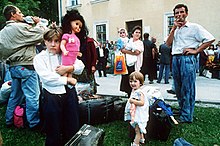Lašva Valley ethnic cleansing
| Lašva Valley ethnic cleansing | |
|---|---|
| Part of Bosnian War | |

|
|
| Location | Lašva Valley, Bosnia and Herzegovina |
| Date | May 1992 − April 1993 |
| Target | Bosniaks |
|
Attack type
|
ethnic cleansing |
| Perpetrators | Croatian Defence Council (HVO), Croatian Army (HV) |
| Motive | implementation of the objectives set forth by Croat nationalists in November 1991 |
The Lašva Valley ethnic cleansing, also known as the Lašva Valley case, refers to numerous war crimes committed during the Bosnian war by the Croatian Community of Herzeg-Bosnia's political and military leadership on Bosnian Muslim (Bosniak) civilians in the Lašva Valley region of Bosnia-Herzegovina. The campaign, planned from May 1992 to March 1993 and erupting the following April, was meant to implement objectives set forth by Croat nationalists in November 1991. The Lašva Valley's Bosniaks were subjected to persecution on political, and religious grounds, deliberately discriminated against in the context of a widespread attack on the region's civilian population and suffered mass murder, rape, imprisonment in camps, as well as the destruction of cultural sites and private property. This was often followed by anti-Bosniak propaganda, particularly in the municipalities of Vitez, Busovača, Novi Travnik and Kiseljak.
The International Criminal Tribunal for the Former Yugoslavia (ICTY) has ruled that these crimes amounted to crimes against humanity in numerous verdicts against Croat political and military leaders and soldiers, most notably Dario Kordić. Based on the evidence of numerous HVO attacks at that time, the ICTY Trial Chamber concluded in the Kordić and Čerkez case that by April 1993 Croat leadership had a common design or plan conceived and executed to ethnically cleanse Bosniaks from the Lašva Valley. Dario Kordić, as the local political leader, was found to be the planner and of this plan. Further concluding that the Croatian Army was involved in the campaign, the ICTY defined the events as an international conflict between Bosnia and Herzegovina and Croatia.
...
Wikipedia
